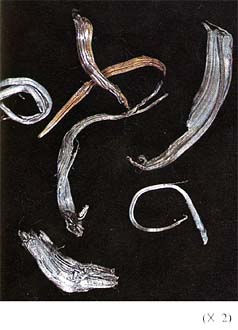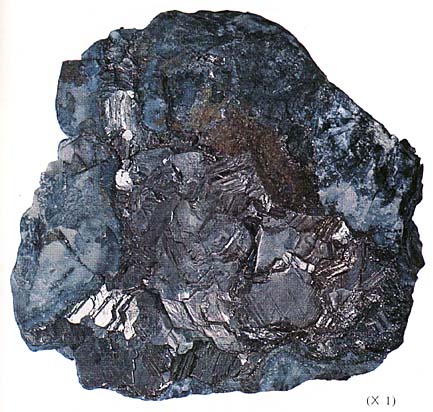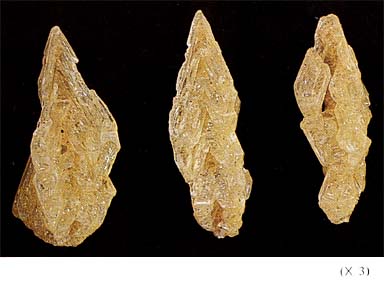Copper, Cu, Cubic, Fm3m
< Specimens No.I-l—No.I-21 >
Specimen No. I-1, from the Okinazawa Mine, Iwate Pref., occurs in a fracture of an altered rhyolite, forming a dendritic aggregate of distorted crystals.
Specimens Nos. I-2 & I-3, from the Osarizawa Mine, Akita Pref., occur in oxidized ores of an epithermal copper deposit, as dendritic aggregates of distorted octahedra with rough o(111) faces.
Specimens No. I-4—No. I-7, from the Arakawa Mine, Akita Pref., are a secondary product in an oxidized zone of an epithermal copper deposit. They form dendritic aggregates of distorted octahedral crystals with o(111) with cuprite on their surfaces.
Specimens Nos. I-8 & I-9, from the Kanose Mine, Niigata Pref., occur in an oxidized zone of an epithermal chalcopyrite-quartz vein and with incrustations of cuprite.
Specimen No. I-10, from the Ogoya Mine, Ishikawa Pref., occurs as a dendritic aggregate filling a fracture of a chalcopyrite-quartz vein in an oxidized zone. It is intimately associated with cuprite which forms crustal aggregates on the dendrites.
Specimens No. I-11—No. I-19, from the Iwami Mine, Tottori Pref.,
are dendritic aggregates of distorted octahedra, covered in part by cuprite
and thin incrustations of malachite. They occur in an oxidized zone of copper-sulphide
ores in an epithermal network deposit (Fig. 1).

Specimens Nos. I-20 & I-21, from Calumet Hecula, Michigan, U.S.A., occur as dendritic masses filling interstices of conglomerates.
Silver, Ag, Cubic, Fm3m
< Specimens No. I-22—No. I-32 >
Specimen No. 1-22, from the Osarizawa Mine, Akita Pref., occurs as small grains in association with earthy hematite on the surface of quartz in an oxidized ore from an epithermal gold-silver-copper-lead-zinc deposit.
Specimen No. I-23, from the Takachi Mine, Niigata Pref., occurs as small flakes filling a fracture of a quartz vein in an epithermal gold-silver deposit. The vein contains minute-grained electrum, argentite and other sulphide minerals togetlier with adularia.
Specimens No. I-24—No. I-26, from the Omodani Mine, Fukui Pref., occur as dendritic foils cutting through a massive copper ore from an epithermal copper deposit. The ore includes bornite, chalcopyrite, galena and a small amount of argentite. The foil-shaped native silver is 1 mm thick.
Specimen No. I-27, from the Rendaiji Mine, Shizuoka Pref., is a whisker-like crystal 1 cm long and 1 mm in diameter, and occurs in a cavity of a quartz vein with a black banded texture (namely, "Ginguro") and containing fine-grained electrum, argentite and other sulphide minerals.
Specimen No. I-28 and specimen No. I-29 are from the Kanagase Deposit and the Tasei Deposit, respectively, of the Ikuno Mine, Hyogo Pref. The former occurs as a dendritic thin foil in a massive copper ore composed of bornite and chacopyrite, and the latter occurs in white-coloured massive calcite in a sphalerite-galena ore from a polymetallic deposit of the xenothermal type and forms irregular-shaped dendritic aggregates.
Specimens No. I-30—No. I-32, from the Koryeong Mine, Korea, are
crystals of whisker-like or wiry shape, often in cotton-like aggregates, in
drusy parts of a quartz vein bearing pyrite and sphalerite in a mesothermal
gold-silver deposit. The longest whisker in specimen No. I-30 measures 3 cm
(Plate 3).

SILVER (No. 1-31) Koryeong Mine, Korea
Gold, Au, Cubic, Fm3m
< Specimens No. I-33—No. I-58 >
Specimen No. I-33, from the Todoroki Mine, Hokkaido, occurs in a quartz vein containing silver sulphides and other sulphide minerals in an epithermal gold-silver deposit, and forms minute grains associated with electrum which is also in minute grains.
Specimen No.I-34, from the Osarizawa Mine, Akita Pref., occurs in an oxidized zone of a copper-bearing quartz vein in association with limonite, and forms fine grains up to 1 mm in diameter.
Specimen No.I-35, from the Hinokinai Mine, Akita Pref., occurs in an epithermal quartz vein as fine grains filling the boundaries between masses of granular quartz.
Specimen No. I-36, from Kawasakizawa, Tamagawa, Akita Pref., occurs in a placer deposit as sm all grains up to 2 mm in diameter.
Specimen No. I-37, from the Kamaishi Mine, Iwate Pref., occurs as small grains in white massive calcite in a pyrometasomatosed limestone.
Specimen No.I-38, from the Marumori Mine, Iwate Pref., is a small grain from a placer deposit originated from an epithermal gold-silver-bearing quartz vein.
Specimen No.I-39, from the Shishiore Mine, Miyagi Pref., occurs as fine grains in a mesothermal gold-silver quartz vein bearing minute amounts of pyrite, galena and chalcopyrite.
Specimen No. I-40, from the Sado Mine, Niigata Pref., occurs as small grains in a black band consisting of silver sulphides and other sulphide minerals in a chalcedonic quartz vein of epithermal origin. This specimen came from seaside gravel, which is worked by dredgers as gold-silver ore.
Specimen No.I-41, from the Akatani Mine, Gifu Pref., occurs as small grains or flakes in a quartz veinlet in a rhyolitic rock and filling gaps in the aggregate of euhedral quartz crystals.
Specimen No. I-42, from the Owaku Mine, Gifu Pref., occurs as fine grains in a massive quartz of epithermal origin.
Specimen No.I-43, from the Tasei Deposit of the Ikuno Mine, Hyogo Pref., occurs as small grains in crystalline quartz of xenothermal origin and is associated with pyrite.
Specimens Nos.I-44 & I-45, from the Nakase Mine, Hyogo Pref., occur as small flaky grains filling the boundaries of crystalline quartz in a mesothermal vein bearing freibergite, stibnite, pyrite, sphalerite and dolomite.
Specimen No. I-46, from the Agawa Mine, Yamaguchi Pref., occurs in fine grains in greyish massive pyrophyllite.
Specimens Nos. I-47 & I-48, are from the Yamagano Mine, Kagoshima Pref. The former occurs as an aggregate of small foils on euhedral quartz, and the latter as small grains included in pseudomorphs of quartz after calcite in drusy cavities in an epithermal quartz vein. The crystals of an octahedral form reach 0.5 mm in diameter.
Specimen No. I-49, from the Hwapyo Mine, Korea occurs in a mesothermal
quartz vein, and forms dendritic aggregates of distorted cubes and octahedra.
The largest specimen weighs about 14 gr. (Plate 3).

GOLD (No, 1-49) Hwpyo Mine, Korea
Specimens Nos. I-50 & I-51, from the Yulpo Mine, Korea, occur as aggregates of small flakes in a white massive quartz vein in association with a small amount of galena.
Specimen No. I-52, from Ugu, Korea, occurs as small grains in grey massive quartz in alaskite.
Specimen No, I-53, from the Holgol Mine, Korea, forms a minute grain, 0.5 mm across, as an inclusion in a cube-shaped pyrite crystal from a contact deposit.
Specimen No. I-54, from the Sorim Mine, Korea, occurs in light grey massive quartz from a mesothermal quartz vein, and forms a small flaky aggregate.
Specimen No. I-55, from the Zuiho Mine, Formosa, occurs as a small flaky aggregate filling gaps in an aggregate of euhedral quartz crystals in an epithermal quartz vein which cuts through black slate.
Specimens Nos. I-56 & I-57, from the Kinkaseki Mine, Formosa, occur as small grains in chalcedonic quartz of epithermal origin.
Specimen No. I-58, from Siberia, U.S.S.R., occurs in a placer deposit, forming rounded grains. The largest grain weighs about 3 gr.
Mercury, Hg, Liquid
< Specimens No. I-59—No. I-61 >
Specimens Nos. I-59 & I-60, from the Shamani Mine, Hokkaido, occur as minute drops in association with cinnabar in a white quartz vein in an epithermal mercury deposit.
Specimen No. I-61, from Fujino, Okayama Pref., occurs in altered andesite in a pyrophyllite deposit as minute drops associated with cinnabar in thin films.
Iridosmine, (Os, Ir), Hexagonal, P63/mmc
< Specimens Nos. I-62 & I-63 >
Specimen No. I-62, from the Tomarinaigawa River, Hokkaido, occurs in a placer deposit as steel grey minute grains, 0.5 mm across, and in association with granular gold up to 0.5 mm in diameter.
Specimen No. I-63, from the Yubari District, Hokkaido, occurs with placer gold and platinum in river sediments, forming flattened grains up to 0.5 mm in diameter.
Arsenic, As, Trigonal, R![]() m
m
< Specimens No. I-64—I-69 >
Specimens No. I-64—I-69, from the Akatani Mine, Fukui Pref.,
occur in an altered rhyolite (quartz liparite) and form globular masses of
concentric and radial aggregates of rhombohedral crystals showing a comfit-like
habit. They are dark grey in colour, but the fresh fracture is steel grey
with metallic lustre (Fig. 2).

Bismuth, Bi, Trigonal, R![]() m
m
< Specimens No. I-70-No. I-85 >
Specimen No. I-70, from the Ashio Mine, Tochigi Pref., occurs in fine-grained, grey to light grey, massive quartz from a xenothermal polymetallic deposit, and forms massive aggregates of granular crystals with perfect cleavage on (0001). Each grain is a few millimeters in diameter. It is associated with a small amount of bismuthinite as a thin layer over bismuth.
Specimen No.I-71, from the Ebisu Mine, Gifu Pref., has been separated from a pneumatolytic wolframite-bearing quartz vein, and forms small masses up to about 5 mm in diameter. The central part of the mass is native bismuth, which is surrounded by dark grey zavariskite, and the earthy outer part, greyish yellow in colour, is koechlinite. These two minerals are alteration products of native bismuth.
Specimen No. I-72, from the Tsubakihara Mine, Gifu Pref., occurs in a pneumatolytic quartz vein, forming small masses.
Specimen No. I-73, from the Nakase Mine, Hyogo Pref., occurs as small granular masses in a mesothermal gold-silver quartz vein and is associated with stibnite.
Specimens No. I-74—No. I-85, from the Kanagase Deposit of the Ikuno
Mine, Hyogo Pref., occur in light grey to dark grey, fine-grained quartz
from a xenothermal metallic deposit, and form aggregates of irregular-shaped
crystals with perfect cleavage on (0001), the largest cleavage plane being
larger than 7 cm in diameter. They are associated with ferberite, chalcopyrite,
tetrahedrite and sporadic cassiterite. Bismuthinite occurs in the outer part
of the aggregate as an alteration product from bismuth. Though rarely, ikunolite
(Bi4(S, Se)3) is associated in small platy crystals
such as in specimen No. I-78 (Plate 3).

BISMUTH(No. 1-83) Jkuno Mine, Hyogo Pref.
Graphite, α-C, Hexagonal, P63/mmc
< Specimens No. I-86—No. I-88 >
Specimen No. I-86, from Gue, Ishikawa Pref., occurs in a crystalline
dolomiteas thin plates up to 2-3 mm in diameter (Fig. 3).

Specimen No. I-87, from Yoshigahara, Gifu Pref., occurs in a white crystalline limestone, and forms a thin tabular hexagonal crystal, 1 mm across.
Specimen No. I-88, from the Amo Mine, Gifu Pref., is thin platy crystals in foliaceous aggregates in nests and veins in gneiss.
Sulphur, α-S, Rhombic, Fddd
< Specimens No. I-89—No. I -100 >
Specimens Nos. I-89 & I -90, from Iwakisan, Aomori Pref., occur as
sublimate mineral in craters of an active volcano, and form yellow transparent
small prismatic crystals with p(111), n(011), s(113), c(001) and e(101). Twins
are frequent with [101] as its axis (Fig. 4).

Specimens No. I-91—No. I -93, from Dake Hot Spring, Aomori Pref., occur in fractures in an altered volcanic rock in the crater of an active volcano, and form lemon-yellow transparent small crystals up to 2 mm across. Pyramidal faces are welldeveloped.
Specimen No. I-94, from the Tsurugizan Mine, Iwate Pref., occurs as sublimate deposit from a volcanic fumarole, forming a yellow massive aggregate with pyramidal crystals in a druse. They are a few millimeters in length.
Specimen No. I-95, from the Kiritomedairayama, Akita Pref., occurs
as sublimate product in a volcanic rock, and forms a canary-yellow transparent
pyramidal crystal, 2cm long, with p(111) dominant and in parallel growth along
the c axis (Plate 4).

SULPHUR (No. I-95) Kiritomedaira yama, Akita Pref.
Specimen No. I-96, from the Kumazawa Mine, Akita Pref., occurs around a volcanic fumarole as sublimate mineral, and forms canary-yellow massive aggregate.
Specimens Nos. I-97 & I-98, from Kawarage, Akita Pref., occur as network impregnations in an altered volcanic rock. The crystals are yellow, transparent, and prismatic with p(111) dominant. Some of them show a skeleton-shaped depression on p(111).
Specimens Nos. I-99 & I-100, are from the Kinkaseki Mine, Formosa. The former occurs in an enargite-luzonite bearing epithermal quartz vein and is associated with alunite, forming a chrome-yellow massive aggregate. The latter occurs in amygdules of an altered rhyolite as small grains.
Tellurium, Te, Trigonal, P3121 and P3221
< Specimens No.I-101—No. I-107 >
Specimens No. I-101—No. I-106, from the Teine Mine, Hokkaido, occur as aggregates of acicular crystals in fine-grained ceramic-like quartz in association with tabular crystals of barite and small amounts of sphalerite and galena from an epithermal gold-silver deposit.
Specimen No. I-107, from the Hinokizawa Deposit of the Rendaiji Mine,
Shizuoka Pref., occurs in white ceramic-like quartz in an epithermal gold-silver
deposit. It forms a fine-grained mass and shows tin-white colour with metallic
lustre (Plate 4).

TELLURIUM (NO. I-107) Rendaiji Mine, Shizuoka pref.